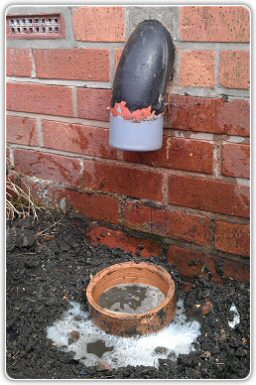


Blocked Drains
Our home drainage system is not something we tend to think about too much - until of course, things start to go wrong...
So for those drain problems causing you nightmares - why not let us handle it for you? With our technical expertise, tools and gizmos, and super-friendly Customer Service second to none, why not give us a try on the number at the top of the page!
Want us to help?
Blocked and clogged drains are just something you're going to bump into sooner or later, and that's where we at CORE are ready to help! Amongst the pages of this website, you'll find many Frequently Asked Questions as well as numerous Hints & Tips to assist in the maintenance of your home's drainage system - and should you need that extra helping hand, we're only a phone call or an email away!
So what causes blocked drains?
Well, it's mainly down to something entering the system, the system was not designed to handle. Put simply, if it isn't water, then it can block your drain! Of course, well-designed modern drainage systems often cope magnificently with all manner of dirt and waste, but for everything that isn't inorganic liquid or rapidly biodegradable, you're really just increasing the chances of a blockage occurring.
Some of the most common causes of blockage include hair, soil, leaves, grease and foreign objects such as jewellery, nuts, screws, mortar and hairclips. All these things can be prevented from entering your system with a little care and the good practice of utilizing grids, grills and filters.
Other contributing factors toward a blocked drain, are:

Trees
The roots of a tree will seek out the nearest water source. If your drainage system is not sufficiently protected, chances are it will be infiltrated. Once a root enters the system, perhaps via a crack in the pipe or a poorly constructed joint, it can grow, expand, and eventually destroy the pipe. To avoid expensive replacement of all affected piping, root damage has to be caught early. An early sign may be slow drainage and gurgling toilets; of particular note should you have trees or hedgegrows near your system.
Subsidence
Although not so common, some properties do suffer from subsidence. This affects the downward motion of a structure, be it a wall, a pipe, or simply some garden flagging. Common causes in these instances would usually be down to the flow of groundwater and the seasonal effects on trees and foundations. As far as pipework is affected, unless it's been strengthened or designed to cope, it may fracture or split at a joint. A general rule of thumb to avoid subsidence problems, would be to ensure your drainage systems are flowing correctly and efficiently, and to ensure trees and large shrubbery are not planted close to your property.
Poor Workmanship
Those reponsible for installing your plumbing and/or drainage system may have cut corners in the construction. There are numerous points of importance to observe and adhere to in the construction of any waste pipe assembly. The difference between superior and poor workmanship lies in the observance of these points. It doesn't help, that much of this work is concealed behind panelling, walls and paving; and that's why at CORE, you're welcome to watch and inspect at any stage of the process.
Doing It Yourself?
Well, having a good idea of the location of a blockage is an important factor prior to implementing any work. So in the first instance the blockage should always be assessed. A good assessment of the blockage will help deal with the job more efficiently, therefore saving both time and expense.
Locate your access points. Access within a drainage system to clear a blockage is very important. Not so much of a problem with new properties, where access gullies, rodding points, manholes and inspection chambers are generally the norm. However, older properties may not have the necessary access and therefore clearing a blockage can often prove somewhat difficult. In this instance we may require the addition of an access point, which would provide both the required access to enable successful clearing, and a useful tool for any future self maintenance.
Once assessed, the blockage can then be cleared using numerous methods and items of equipment; from simple rods and plungers to mechanical clearing or the use of a high-pressure water jetting machine. However, having assessed the work first, we should now have a good understanding of how to tackle the blockage and with what equipment.
After clearing the blockage, the system flow should be tested, and if necessary, surface areas where work has been implemented should be cleaned, and any debris removed.
The benefit of experience should not be underestimated, so do take great care and do your research before tackling your own blockage - the last thing you want is to make matters worse!